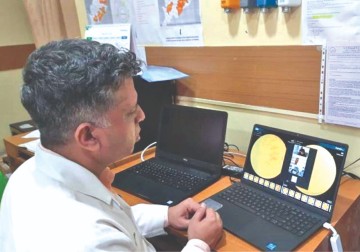In a new study from LVPEI, Dr. Tapas R. Padhi, Souvik Bhunia, and others have evaluated the feasibility of remote diagnosis of retinopathy of prematurity using real-time telescreening.
Retinopathy of prematurity (ROP) is a sight-threatening ocular disease that affects preterm babies. In ROP, an abnormal proliferation of blood vessels in the infant’s retina leads to internal bleeding and scarring of the eye’s innermost layer. The infant has a small window opportunity (30 days from birth) during which ROP can be identified and treated with good outcomes. Typically, ROP diagnosis is done at a hospital’s neonatal intensive care unit, where an ophthalmologist uses a binocular indirect ophthalmoscope to examine the infant’s eyes. This system is limited by the availability of ROP-trained ophthalmologists.
Teleophthalmology can help overcome the hurdle of poor healthcare access by delivering quality eye care over the internet. Mobile paramedics trained in high-quality imaging of the retina can bridge the distance between a preterm infant and an ophthalmologist in a hospital. However, current ROP telescreening uses a ‘store and forward protocol,’ where the paramedic takes images of the retina, stores them in a phone or laptop, and shares them with a hospital—the full cycle taking minutes or hours, to a full day. Sometimes, there are additional steps, where skilled technicians grade the image before an ROP specialist sees them. This creates a gap between the doctor and the patient’s parents—there is also no scope for real-time, two-way interaction. Is current telecommunication technology sufficient to make live telescreening of ROP feasible?
In a new prospective study published in the Indian Journal of Ophthalmology, Dr. Tapas R. Padhi, Souvik Bhunia, and others from LVPEI evaluate the feasibility of ROP telescreening via live video conferencing. The study was conducted in six rural districts of Odisha. In this study, ophthalmic personnel took retinal images of 576 babies (1152 eyes) at risk of ROP over a 9-month period. During each screening, an experienced ophthalmologist at an LVPEI tertiary hospital several kilometers away watched the live feed of a patient’s retina. The study also compared the efficacy of live telescreening with the gold standard of in-person ROP screening, conducted by an ROP-trained ophthalmologist on a sub-sample of 100 non-consecutive babies.
In total, real-time ROP telescreening (RRT) saved 47,406 hours (1,975 working days) of travel for the babies and their parents. RRT also saved time for the ROP specialists who reduced travel by 477 hours (48 working days). Over the study period, RRT saved INR 11 crore (USD 1.3 million), underscoring the economic benefits of remote diagnosis. Sub-sample analysis showed that RRT had high sensitivity for detecting ‘referral-warranted’ ROP at 97.2%, with a specificity of 75%. RRT was also able to avoid false negative results 93% of the time and false positives 79% of the time. RRT’s efficacy was comparable to in-hospital screening. The study demonstrates that RRT is not only sensitive enough for accurate referral-warranted ROP diagnosis, but it can also save significant travel time and money.
‘It is a logistical challenge for ophthalmologists to go around to every hospital and screen preterm babies for ROP, especially in rural areas,’ remarks Dr. Tapas Ranjan Padhi, a vitreoretinal ophthalmologist at LVPEI and the corresponding author of this paper. ‘Telescreening is the answer to this problem, both in terms of diagnostic accuracy and the added benefit of cost savings.’
Citation
Padhi, T. R., Bhunia, S., Das, T., Nayak, S., Jalan, M., Rath, S., Barik, B., Ali, H., Rani, P. K., Routray, D., & Jalali, S. (2024). Outcome of real-time telescreening for retinopathy of prematurity using videoconferencing in a community setting in Eastern India. Indian Journal of Ophthalmology. Advance online publication. https://doi.org/10.4103/IJO.IJO_2024_23



